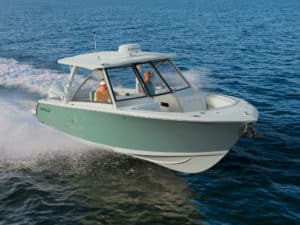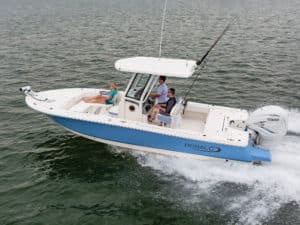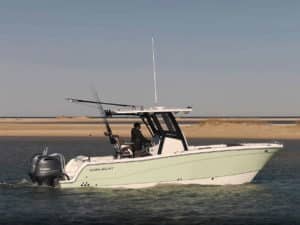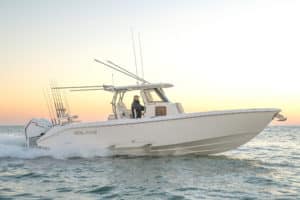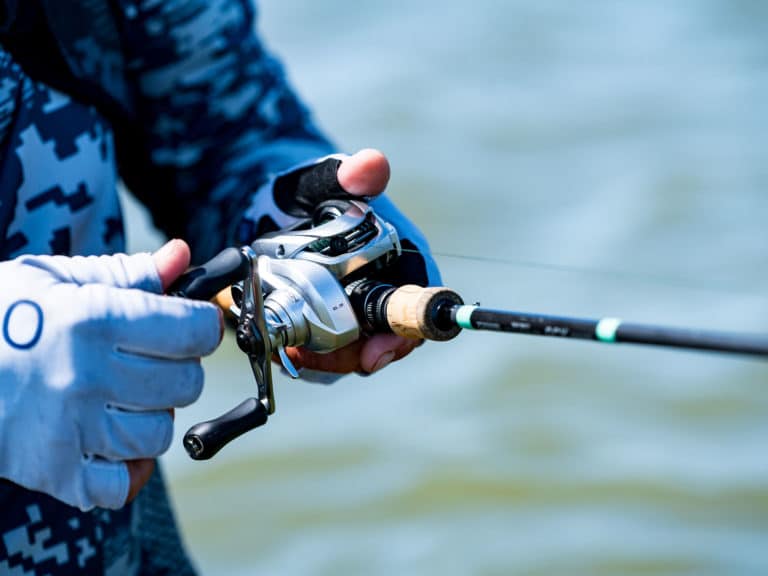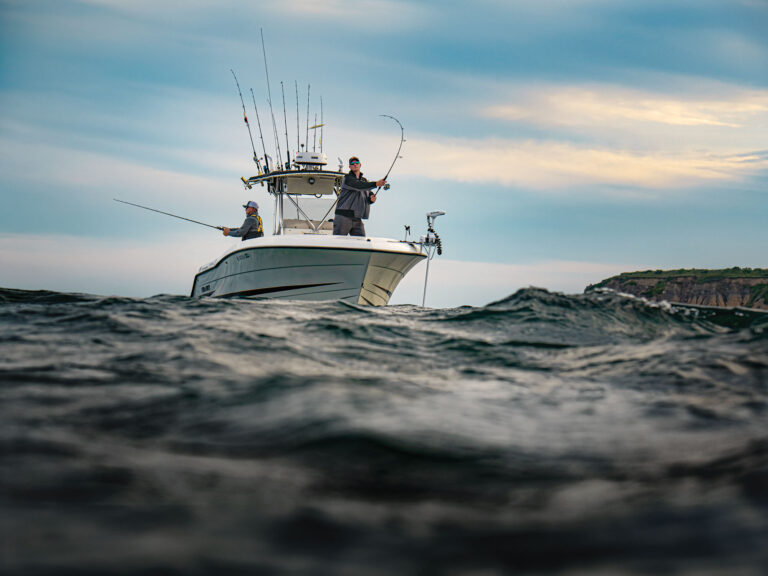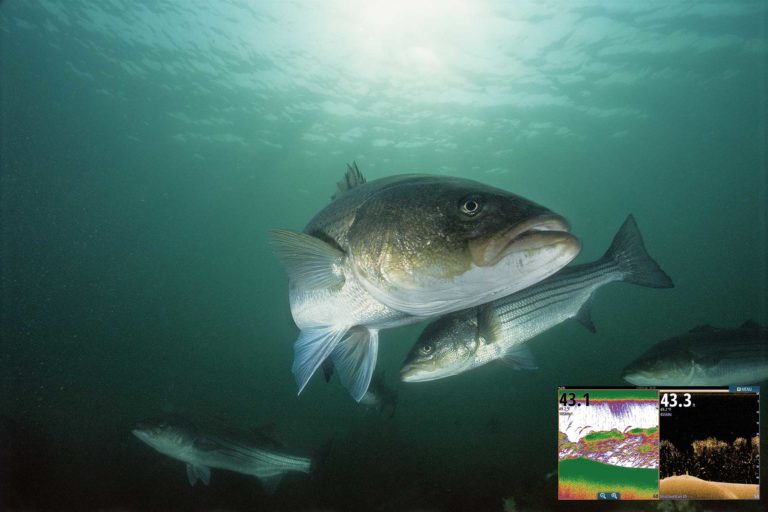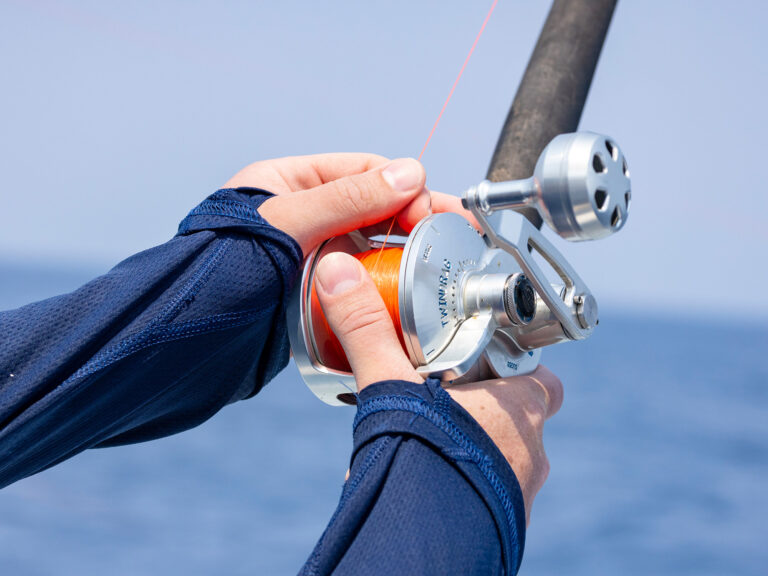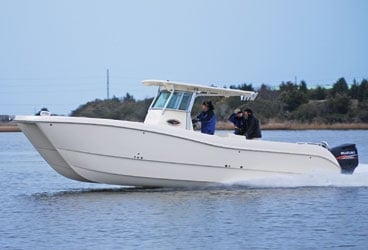
0410worldcat_368
Historically, traditionalists have criticized power catamarans as unattractive. But the evolution continues. For example, look at a World Cat in profile, and what you’ll see is a sleek, graceful sheer line, a proud bow and aesthetics born of Carolina offshore fishing. Not much in our world is more aesthetically pleasing than that!
Performance
Heading out Miami’s Government Cut, I engaged wide-open throttle, jumping to 52.2 mph at 5,900 rpm while burning 50.3 gph. I found optimum cruise at just more than 33 mph, turning 4,000 rpm using 19.8 gph – pretty darn good for 600 hp! Trolling at 71/2 mph (1,500 rpm) and using about 3 gph, the 320 generated two very distinct alleys with centerline turbulence from the combined wash of the tunnel and the twin props and very modest surface white water. All in all, it created a very nice, clean wake.
Throttle up and the Suzuki 300s lift the 320 onto plane in the blink of an eye. Advance the throttles conservatively for zero bow rise. Proper engine trim becomes even more crucial than is usual on a catamaran. Cats use the engines to provide the same fore, aft and lateral boat trim that tabs do on other boats. I say “crucial” because optimum performance only comes with knowledgeable handling. Bow down in a head sea, bow up running down-sea and trim the engines in opposite directions to affect side-to-side leveling.
World Cat also builds in a hydropod at the front end of the tunnel to virtually eliminate the sneezing effect that comes at slow speed in a head sea when one wave closes off the tunnel and the next follows it, compressing the air between them. The air escapes through the avenue of least resort – back out the tunnel – where the wind catches the mist and blows it back on the windshield. Not a problem on a World Cat!
Another performance benefit of this boat is that it backs down straight and quickly, at speeds above idle, which is rare for outboard boats. In fact, this boat backed down as well as any inboard twin screw. The 320 leans nicely into turns and can carve an amazingly tight arc safely.
Drifting abeam to three- to four-foot, close-together seas proved a nonevent, debunking another myth: Power cats are very stable.
One final performance note about the Suzukis: Electronic controls often shift gears so gently and easily that you sometimes don’t know what gear you’re in. The Suzuki electronic controls provide both audible and visual notification each time you shift. You hear a beep, and the name of the gear you have just entered – forward, neutral or reverse – flashes briefly on the electronic engine-monitor gauges.
Fishing
Every seat and deck box aboard the World Cat 320 is generously insulated. Large in-deck fish boxes to port and starboard drain via whale-gusher diaphragm pumps rather than macerators. Macerators generate more warranty claims than most any other equipment. Diaphragm pumps may drain slightly more slowly, but you can pump an entire baitfish through one. I also appreciate how well engineered the fish boxes are with their gaskets and tight fits. This means that not only can you just let the box close without slamming, but you can avoid saltwater intrusion into your valuable ice supply.
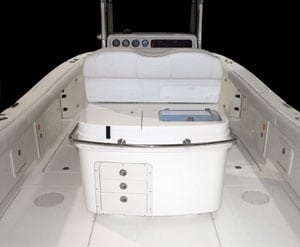
At the forward end of the console under each gunwale are curved catches that open to reveal lockable rod storage. A deluxe leaning post accommodates two people and features flip-up bolsters, comfortable padding and a full-blown tackle center with sink, tackle drawers and a 45-gallon, sky-blue livewell on the module’s back side.
Every angler appreciates one signature World Cat feature: the mammoth transom walk-through. Extending out from the walk-through is a swim platform that lets you readily get your rod tip way out past the outboards, while the big folded-up swim ladder acts as a rail to keep you safely on board.
Design and Construction
Anyone who deep-drop bottomfishes will like the enormous anchor locker, which negates the need for a basket to stow your 1,000-foot anchor rode. It will all fit in the bow with room to spare.
The dashboard easily handles a pair of 15-inch chart-plotter displays in addition to other assorted electronics.
This hull design – identical to the World Cat 32 Express – features significant construction differences. For example, Word Cat vacuum-bags and resin-infuses this model. In other words, the company lays all the dry, bidirectional fiberglass and the DIAB composite-foam coring into the mold then vacuum-bags it all and literally sucks the vinylester resin from one end through to the other. This makes for a uniform, sturdy and void-free hull, a hull every bit as strong as the old 32 Express but one that tips the scales at 1,100 pounds less. But you still need to drive one on a day you’d rather be home than on the water to truly appreciate what a cat can do to improve your boating life.
LOA……32 ft. 2 in.
BEAM……10 ft. 6 in.
HULL DRAFT……1 ft. 4 in.
DEADRISE……Catamaran
WEIGHT……9,600 lb. (w/ power)
FUEL……300 gal.
MAX POWER……Twin 300 hp OB
MSRP……$233,000 (w/ twin 300 Suzuki OB)
World Cat / Tarboro, North Carolina / 252-641-8000 / www.worldcat.com

